Thank You, Farewell, & Amen
“The Power of the Doctor” bids goodbye to Jodie Whittaker’s Time Lord in barmy and beautiful fashion.
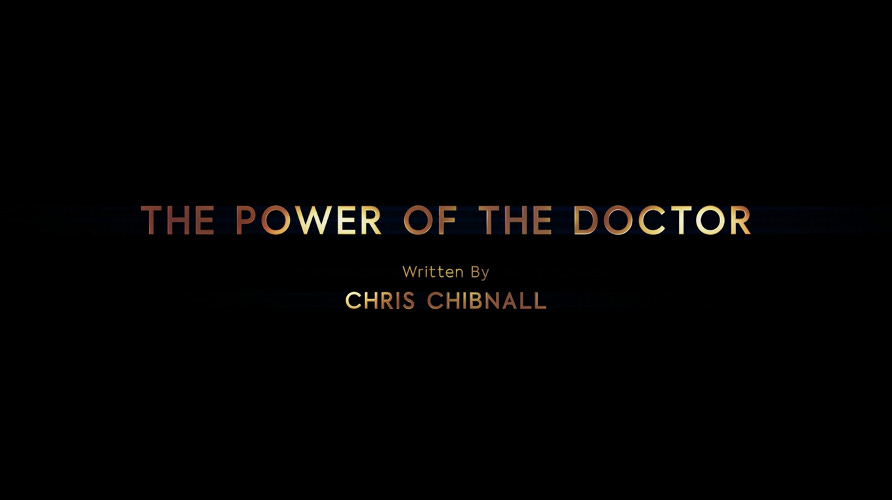
Doctor Who
“The Power of the Doctor”
Series 13, Episode 9 / BBC Centenary Special
Written by Chris Chibnall
Directed by Jamie Magnus Stone
Starring Jodie Whittaker, Mandip Gill, John Bishop, Sophie Aldred, and Janet Fielding
Guest Starring Sacha Dhawan, Jacob Anderson, Anna Andresen, Nicholas Briggs, Richard Dempsey, Neo Rae Gardener, Jo Martin, Sanchia McCormack, Jemma Redgrave, Joe Sims, Bradley Walsh, and David Tennant
Special Guest Stars Colin Baker, David Bradley, Peter Davison, Bonnie Langford, Katy Manning, Sylvester McCoy, Paul McGann, and William Russell
88 minutes
Original broadcast 23 October 2022
1. Weeping Angel
Yes, I cried.
Of course I did.
I also whooped, hollered, punched the air, and jumped off my sofa to applaud more times than seems wise to confess here (or, perhaps, anywhere).
Yet given how titanically entertaining, nutty, overstuffed, and remarkable an episode “The Power of the Doctor” is, such reactions shouldn’t surprise anyone at all, at least anyone familiar with my ardent love—and previous reviews—of Doctor Who.
The fact that this entry sees Jodie Whittaker’s fabulous Thirteenth Doctor race across Doctor Who’s regeneration horizon while celebrating the British Broadcasting Corporation’s (BBC’s) 100th anniversary as a public-television network and resurrects several characters from Classic Who (1963-1989 & 1996) while tipping its hat to every era of the franchise and recalls the cleverest bits of returning showrunner Russell T. Davies’s finales for the Ninth and Tenth Doctors (Christopher Eccleston and David Tennant, respectively) while ratcheting its pace to absurd tempos and impressively distills all of Chris Chibnall’s strengths as New Who’s head writer into 88 pants-on-fire minutes while placing his weaknesses front and center, too . . . well, who could ask for anything more?
Not I, dear reader, not I.
Yet “The Power of the Doctor,” whose narrative imperfections double as storytelling assets—a paradox that summarizes Chibnall’s three-season New Who tenure better than any other statement I might make—isn’t easy to review. How can anyone properly account for an installment whose plot bounces here, there, and everywhere like a mad pinball game jerking and jiggling and juddering its way toward that inevitable moment when the entire enterprise goes TILT!? Yet that moment never arrives, with Chibnall knitting every plot thread, strand, cord, and filament into a patchwork narrative that manages, again and again, to hold together just as it’s about to unravel.
That’s a trick of storytelling legerdemain that shouldn’t be possible, but that’s as fulfilling as it is unlikely thanks to the efforts of a supremely talented production team (led by director Jamie Magnus Stone) and the work of a gifted cast (led by the marvelous, not-to-be-missed, soon-to-be-missed Jodie Whittaker).
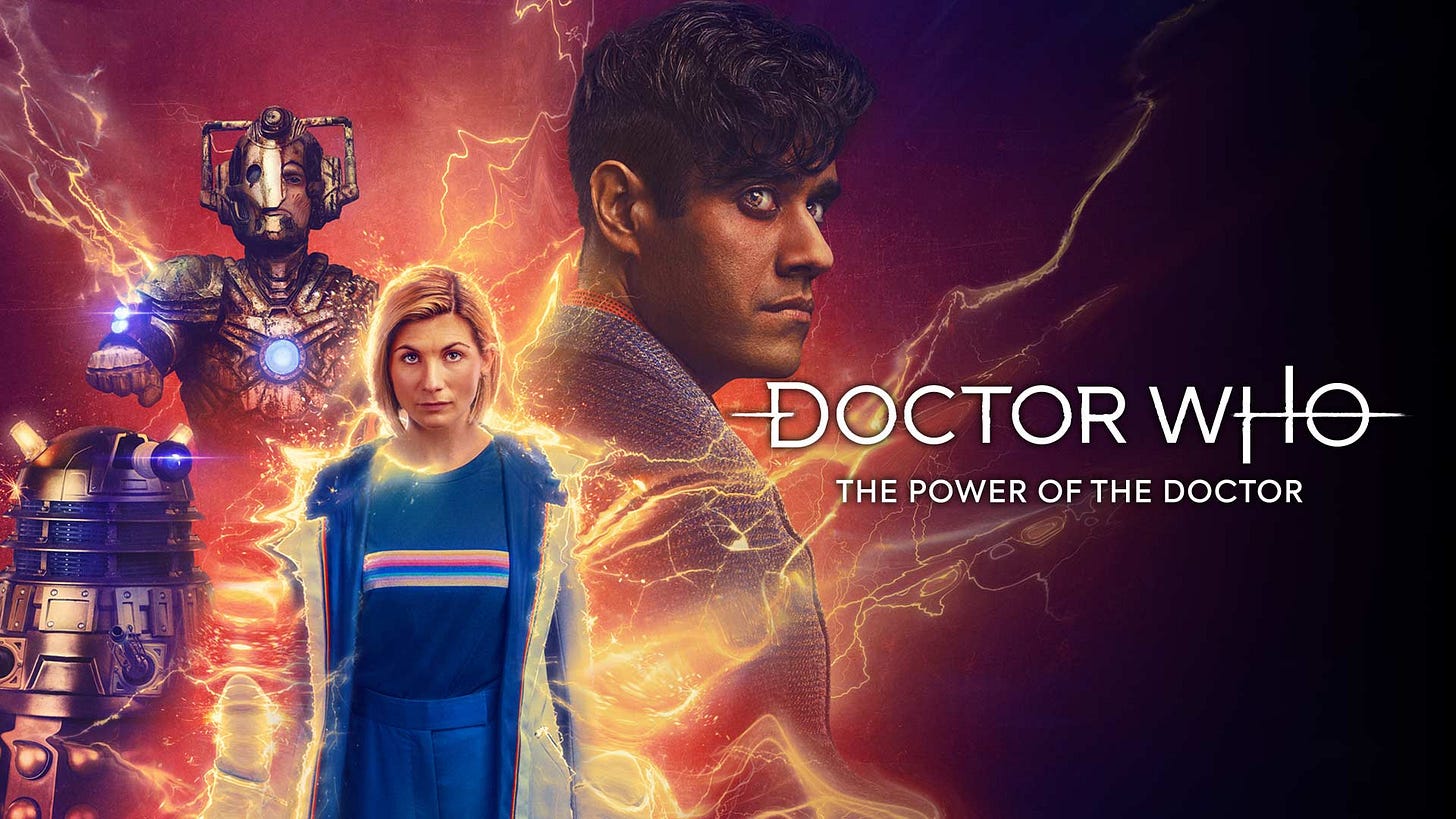
This is the way (to coin a phrase) of Chibnall-era New Who, where everything and nothing make sense, where life and death freely intermingle, where the story zigs from event to event and zags from character to character, where the narrative slips from theme to theme and slides from symbol to symbol, where fears of contradiction and inconsistency and implausibility simply don’t exist. Chibnall, like Russell T. Davies and Steven Moffat before him, writes episodes that lurch down blind alleys, around unseen corners, and into twisty corridors because, if we’re feeling generous, Chibnall credits his viewers’ intelligence to—and, if we’re not, because he doesn’t care how (or even if) we—follow his ever-wilder turns of plot. Yet New Who’s tradition of defying conventional storytelling parameters, sometimes on a whim, makes the former possibility more likely and, one hopes, more accurate.
Chibnall certainly presses “The Power of the Doctor” beyond all reasonable limits in ways that even Series 13’s perplexing, but compelling Flux storyline didn’t attempt. Chibnall, without shame or sense, goes for broke in one sequence that, if this episode were the pinball game mentioned earlier, wouldn’t just hit TILT! but pass this point-of-no-return marker to blow through BANG!, BOOM!, and CRASH! before breaking into pieces that roll around the floor without hope of ever re-assembling themselves.
By doing so, “The Power of the Doctor” beautifully summarizes the Doctor Who franchise (Old and New) to become the perfect capper for the Chibnall/Whittaker era, sending the Thirteenth Doctor off in style without trying or tying up her adventures’ loose ends. That’s a polite way of saying that Chibnall, without sense or shame, makes little effort to resolve the Timeless Child mythology that will forever define his contribution to Who lore and to our memories of his years as showrunner.
And, my friends, this irresolution is just fine, indeed just dandy because, at its heart and in its soul, “The Power of the Doctor” shows us, as well as any episode since “An Unearthly Child” launched the franchise on 23 November 1963, that the Doctor is a conclave of personalities whose commitment to compassion, joy, and wonder remains undiminished 59 years after the TARDIS took its first voyage through the time vortex.
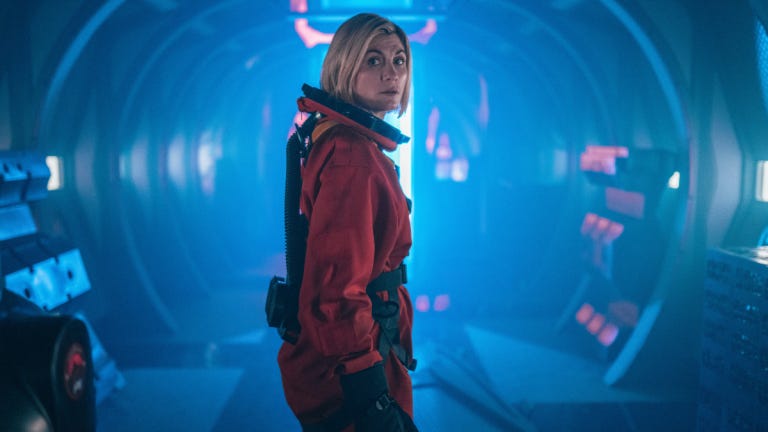
2. Train(ing) Days
This reality doesn’t prevent Chibnall from devoting nearly as much time to Sacha Dhawan’s gloriously insane incarnation of the Master (dubbed “the Spy Master” after his introduction in the Series 12 two-part premiere, “Spyfall”) as to the Thirteenth Doctor. Since inheriting the role of the Doctor from Peter Capaldi in late 2017, Jodie Whittaker’s so graciously handled her onscreen and offscreen duties as the first performer to shatter Doctor Who’s glass ceiling that focusing this much attention upon the Master should raise my hackles. Why, after all, diminish the first female Doctor’s centrality to her final regular appearance as the program’s protagonist by ceding ground to her primary male antagonist, no matter how terrific he may be?
Yet Chibnall so bizarrely dramatizes the Master’s sociopathic perversity that my reservations about the Spy Master’s significance to “The Power of the Doctor” falter before my fascination with how the showrunner, in his final episode as New Who’s runaway-train conductor, steers the program into the uncertain, potentially hostile, yet finally thrilling territory of the franchise’s confused—yet fascinating—approach to the Time Lords’ gender fluidity.
Chibnall, in a move that will launch (if it hasn’t already) hundreds of think pieces, online screeds, and academic dissertations, concocts for the Master a scheme that, while a partial victory for viewers concerned about the representation of women, sounds enough regressive chords that we can’t help but doubt—occasionally, fitfully, and temporarily—Chibnall’s commitment to valuing diversity, pluralism, and respect for all creatures (great and small). This segment’s overarching plot, after all, more than once dilutes the celebratory energy that “The Power of the Doctor” dazzlingly provokes in its first 30 minutes.
You wouldn’t know it given this outing’s blazing-fast inaugural sequence, an action extravaganza set on a bullet train racing through deep space that, for good measure, finds itself under attack by the CyberMasters last seen in Series 12’s finale, “The Timeless Children” (first broadcast on 1 March 2020). Two space-train marshals, Arnhost (Joe Sims) and Halaz (Sanchia McCormack), save as many of this train’s passengers from the CyberMasters’ relentless violence as they can, but this losing battle sees the CyberMaster General (voiced by the ever-reliable and always-redoubtable Nicholas Briggs) torture Halaz to discover the location of the train’s mysterious cargo.
Happily, or unhappily given what happens next, the Thirteenth Doctor (Jodie Whittaker), Yasmin “Yaz” Khan (Mandip Gill), and Dan Lewis (John Bishop)—clad in those spectacularly orange New Who spacesuits first seen in Series 2’s “The Impossible Planet” (initially broadcast all the way back on 3 June 2006)—answer Halaz’s distress call by flying the TARDIS above the bullet train—racing through space at incredible speeds, lest we forget—before clambering down a metal rope-ladder. Thirteen, Yaz, and Dan stand atop the train as it whizzes past massive constellations and through misty nebulae in vibrant images that pop off the screen.
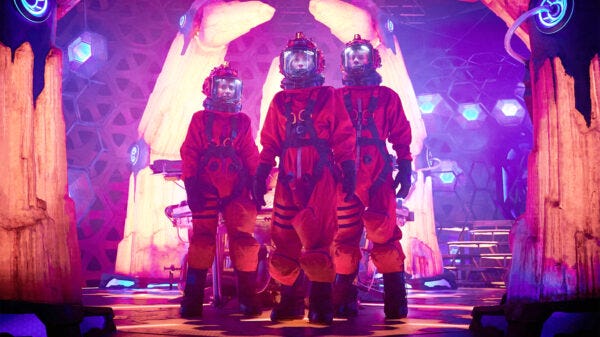
Despite this slam-bang chaos, choreographed by director Jamie Magnus Stone with practiced ease and excellence, careful viewers realize that the presence of the CyberMasters means that, even without seeing him, Sacha Dhawan’s Spy Master has somehow survived Gallifrey’s putative destruction at the end of “The Timeless Children.” This first example of the many allusions to Doctor Who’s past that litter “The Power of the Doctor” reminds us that, as an installment honoring the BBC’s centenary as a public-broadcasting institution, “The Power of the Doctor” will traffic in the franchise’s rich (and contradictory) history, heap oodles of Whovian nostalgia upon us, and offer shameless fan service about which Chibnall, his cast, and his crew feel no embarrassment at all.
So numerous are these callbacks that an equal number of repeat viewings would be necessary to count them all, but, if we list those nifty orange spacesuits and the CyberMasters as the first two examples of Chibnall’s incessant nostalgia-bait, then Number Three can only be the bullet train itself. This vehicle recalls, at least a little, the more elegant space locomotive that the Twelfth Doctor (Peter Capaldi) and Clara Oswald (Jenna Coleman) board in Series 8’s “Mummy on the Orient Express” (first broadcast on 11 October 2014) to let us know that Chibnall will embrace all eras of New Who by honoring the work of his two showrunning predecessors (for those in the back, Davies and Moffat).
Perhaps the most important character beat of this teaser sequence occurs when Dan, just after landing atop the bullet train’s roof (having jumped from the metal rope-ladder, which doesn’t extend all the way down from the TARDIS’s doorway), gets shot in his spacesuit’s facemask by a phalanx of CyberMasters stomping its way toward him. The resulting concussion threatens to deprive Dan of oxygen and knocks him off the train’s roof, forcing Yaz to grab his leg and hold him in place. The resulting imagery, as Chibnall’s script aptly puts it, sees Yaz “flying him like a kite”1 as the CyberMasters continue to attack.
Fret not, dear reader, for even if matters get worse before they get better (as befits any drama worth its weight in space gold), the Doctor deactivates the train roof’s magnetic field and holds Yaz’s leg to prevent her erstwhile companions from tumbling into space alongside the CyberMasters, who’ve clearly never had zero-G training. Hauling Yaz and Dan down to roof level, the Doctor leads them inside the train, where Dan becomes its unofficial conductor by using Thirteen’s sonic screwdriver to slow the locomotive while the Doctor makes her way toward the cargo carriage. She finds a young boy (Neo Rae Gardener) imprisoned inside an ornate chamber, but the CyberMaster General teleports this child away, we know not where, to leave the Doctor flummoxed as “The Power of the Doctor” smashes into its opening credits.
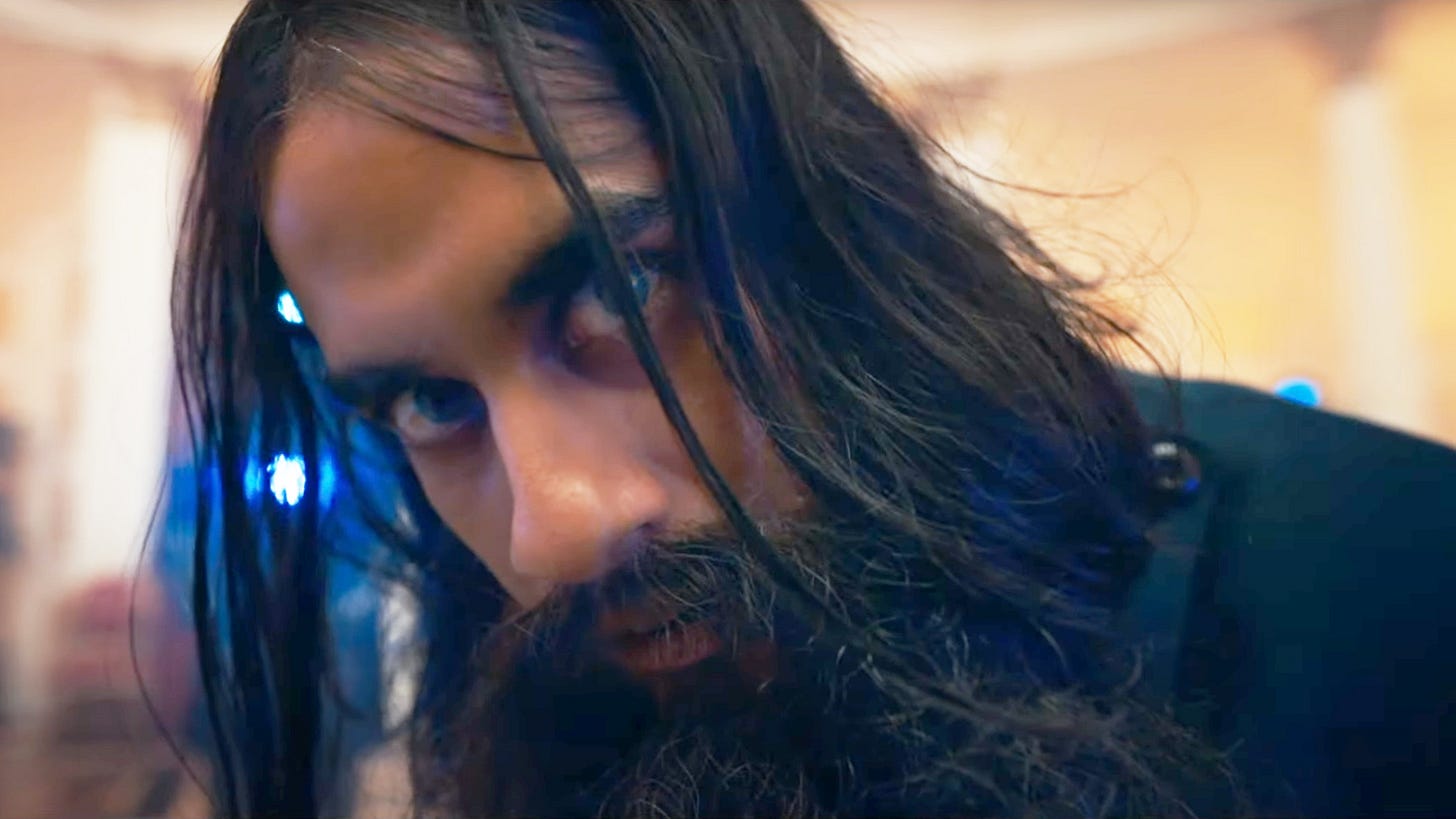
The Master never appears in this teaser, but, to repurpose a phrase that humanities scholars know well, he’s present by his absence—meaning that the Master orchestrates events from far, far away, in this case, from such a temporal and spatial distance that we might wonder how masquerading as Grigori Rasputin in Imperial Russia circa 1916 relates to the train chase that begins “The Power of the Doctor.”
The answer? Well, for one, it’s fun to see Sacha Dhawan wearing blue contact lenses that emphasize the Rasputin Master’s hypnotic powers over Tsar Nicholas II (Richard Dempsey) and Tsarina Alexandra Romanova (Anna Andresen), yet another franchise allusion—this time, to the Master’s Classic Who origins. His (and her) New Who incarnations—whether played by Derek Jacobi, John Simm, or Michelle Gomez—rarely indulge this ability despite Roger Delgado’s urbane, witty, and foundational version of the Master (1.0, so to speak) enjoying it throughout the Third Doctor’s (Jon Pertwee’s) era.
For two, the Rasputin Master gains control over the Romanov dynasty’s vast resources, including its famous Winter Palace, during the middle of World War I, a calamity that forwards his plot to destroy the Doctor by involving what Alexandra calls “the second moon in the sky.”
And what might that be? Oh, nothing less than an entire Cyberplanet occupying an orbit near Earth’s Moon, forcing us to ask ourselves, “What could possibly go wrong?” now that the Master’s somehow converted an entire world—planetoid, moonlet, or whatever term you wish to employ—into a metal-encrusted orb with glowing-blue cyberspires piercing its surface to create a jagged skyline that, in its own way, is hideously beautiful. This development surely won’t have any down-the-line implications for the Doctor, will it?
No, dear reader, not to worry, not to worry—unless, like me, you care about the fates of the Doctor, the world, and the universe, which are tied together yet again as Doctor Who, the trippiest SF franchise of them all, thunders its way forward.
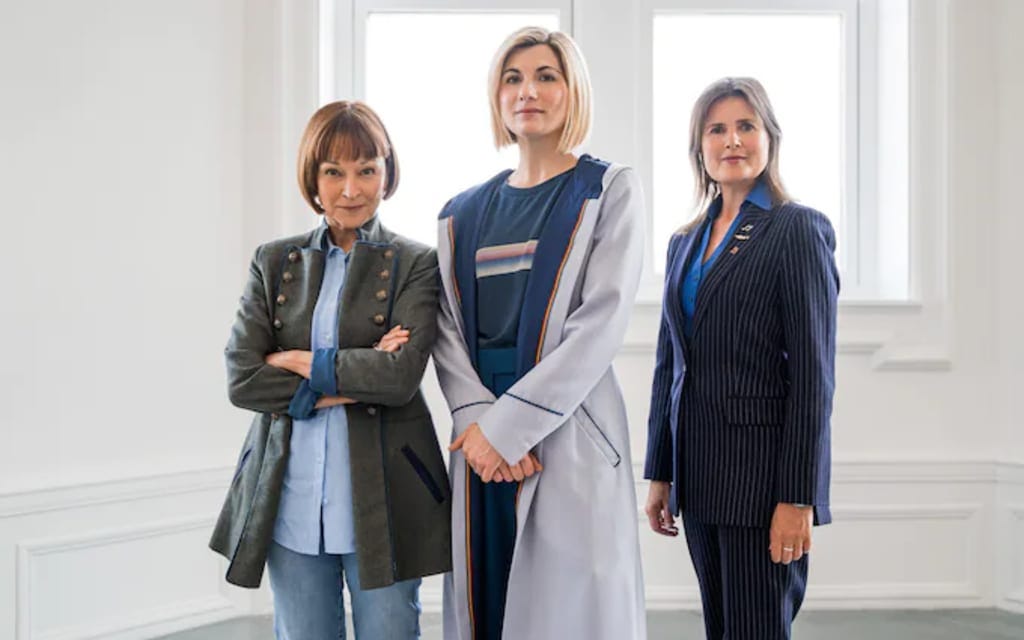
3. Companion City
Chibnall’s script sets a relentless pace that might swiftly degenerate into an impressionistic mess full of scattered images, haphazard jump-cuts, and too-brief character moments. Despite this danger, “The Power of the Doctor”—even while dashing here and sprinting there in the “chicken-with-its-head-cut-off” manner that typifies Chibnall-era New Who—maintains just enough equilibrium to enfold the Master’s scheme, the Doctor’s resilience, and Chibnall’s umpteen allusions to Whovian history into a shaggy, baggy whole that somehow smooths all wrinkles every time it threatens to split its storytelling seams.
These creases become most visible thanks to Chibnall including characters and performers from one of his favorite Classic Who eras: the 1980s’ post-Fourth Doctor/Tom Baker years that saw the Fifth Doctor (Peter Davison), the Sixth Doctor (Colin Baker), and the Seventh Doctor (Sylvester McCoy) take their turns in the TARDIS alongside a variety of companions that gifted the show the gonzo reputation that marks (and, in some quarters, stains) its legacy more memorably than any other period in the franchise’s history.
And if you distrust this pronouncement, just gaze at the Sixth Doctor’s costume, a riot of clashing colors and bizarre patches that Colin Baker has said many times didn’t bother him nearly as much as it did the fans not because the fans are wrong, no, but because he, as the man wearing these can’t-believe-they-made-it-onto-television threads, wasn’t forced to look at them as much as everyone else was.2
Ah, yes, 80s’ Doctor Who was absurd, crazy, cracked, unhinged, and every other adjective that connotes insanity, both before and behind the camera. If you have time, take a few hours, days, or weeks to peruse tell-all, behind-the-scenes books like Andrew Cartmel’s 2005 volume Script Doctor: The Inside Story of “Doctor Who” 1986-1989, Richard Marson’s 2013 exposé JN-T: The Life and Scandalous Times of John Nathan-Turner, and Richard Molesworth’s 2022 book The John Nathan-Turner “Doctor Who” Production Diary 1979-19903 to quash all lingering doubts about just how mad—and, occasionally, deranged—was the daily work of producing Doctor Who during the nine-year reign (1980-1989) of John Nathan-Turner, then and now the longest-serving producer in Doctor Who’s history (although returning showrunner Russell T. Davies will break Nathan-Turner’s record if his second go-round with New Who stretches beyond the year 2026).
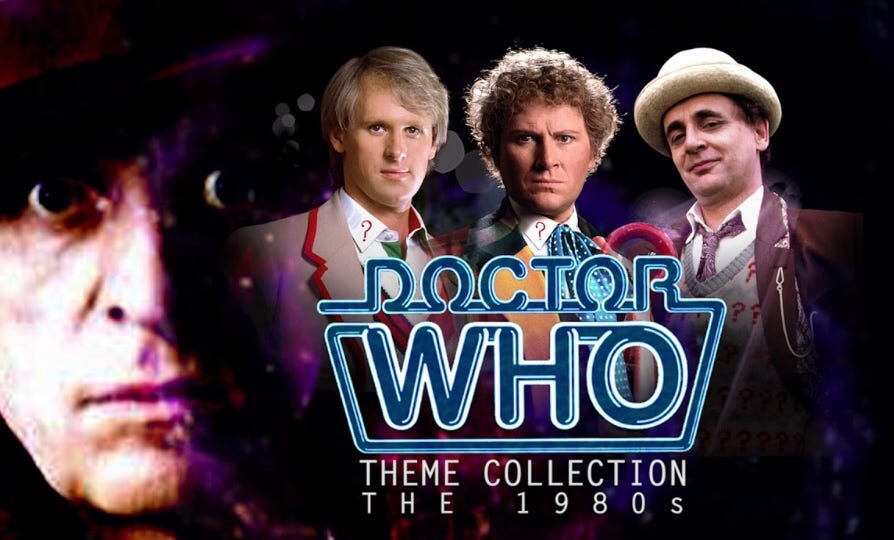
Chibnall wastes little time in returning two of this period’s best characters (and performers) to “The Power of the Doctor” by catching us up with Dorothy “Ace” Gale (or Gale McShane, depending upon which source you trust, played by Sophie Aldred) and Tegan Jovanka (Janet Fielding) as they video-chat about the peculiar facts that 15 world-famous paintings (including Leonardo da Vinci’s Mona Lisa, Edvard Munch’s The Scream, and Grant Wood’s American Gothic) have been removed from public view while 12 leading seismologists have disappeared despite no logical explanation or, worse, connection. Aldred and Fielding, who’ve voiced their characters in Big Finish Productions audio dramas since the turn of the 21st Century, return to onscreen Doctor Who after respective absences of 33 and 38 years to give terrific performances throughout “The Power of the Doctor.”
Tegan remains the acerbic, quick-witted, tart-tongued character we remember, while Ace maintains her optimistic outlook despite being abandoned by the Doctor decades before this episode begins. New Who has explored how the Doctor’s absence affects her (or his) companions before, most notably in Series 2’s “School Reunion” (first broadcast on 29 April 2006), which returned Elisabeth Sladen’s formidable Sarah Jane Smith to television by offering a what’s-she-up-to-now? portrait of this fan-favorite character so lovingly rendered by writer Toby Whithouse and the redoubtable Sladen that this outing begat the playful children’s-television spinoff The Sarah Jane Adventures (2007-2011).
I’d happily watch a program that follows Ace and Tegan tracking alien conspiracies across the globe, but even if that show never materializes, Chibnall writes both characters with gusto. And, if these goodies aren’t enough, Ace and Tegan join Jemma Redgrave’s marvelous UNIT commander Kate Lethbridge-Stewart to fight the Cybermen, the Daleks, and the Master, whose joint appearance in a single installment marks a franchise first that’s also tremendous fun for longtime viewers ticking boxes off their nostalgia checklists.
Yet critical watchers might ask, apart from Chris Chibnall’s desire to see them onscreen again before surrendering New Who’s showrunning reins to Russell T. Davies, why include Ace and Tegan in the Thirteenth Doctor’s final outing at all? One response—flippant yet legitimate—is, “Why not insert them into a centenary special designed to celebrate the program’s and the BBC’s intertwined history?” Another is, “Doing so becomes remarkably entertaining, not to mention long overdue!” Yet a third is, “Packing this segment to the gills, the rafters, or whatever term best pleases you lets Chibnall construct the longest-ever installment of New Who (or, for that matter, Classic Who) while emphasizing the resilience, the significance, and, yes, the power of women in ways the old show rarely did.”
“True enough,” we might respond, but including so many characters from so many periods of the Who franchise—a disaster-movie convention that Chibnall laces throughout his three New Who seasons—risks undercutting the presence of the Thirteenth Doctor and Yaz, her longest-serving and -suffering companion, just as their journeys come to an end.
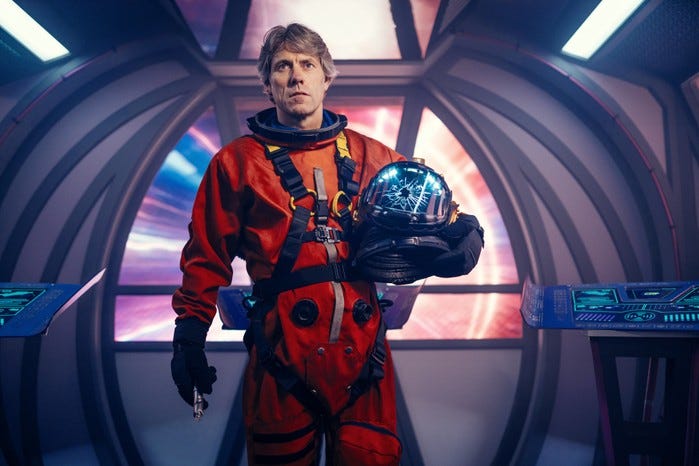
Chibnall’s compulsion to stuff into “The Power of the Doctor” every possible Whovian reference, theme, and trope means that this segment spends less time reflecting upon the Thirteenth Doctor’s consequential place within Doctor Who’s long, rambling, and winding narrative than we might expect. Taking this tack also risks evoking the maudlin sentimentalism that marks the program—particularly the 1980s era that “The Power of the Doctor” so fondly recalls—at its worst.
And Chibnall isn’t finished, refusing to confine himself to reviving only old companions. One price of resurrecting Ace, Tegan, and other Classic Who characters is that someone must take a back seat, so Chibnall offloads Dan Lewis just as the Thirteenth Doctor’s final adventure gets going.
“The Power of the Doctor” slows down enough to enjoy a few sweet moments between Dan, Yaz, and Thirteen after he announces that nearly dying on the space train has made him re-evaluate his priorities. The dangers of traveling with the Doctor outweigh the fun, with John Bishop nicely conveying Dan’s doubt, regret, and resolve in leaving Thirteen’s TARDIS to return to the life of a man who can no longer avoid his responsibilities. This scene unsurprisingly recalls the departures of Ryan Sinclair (Tosin Cole) and Graham O’Brien (Bradley Walsh) at the conclusion of 2021’s New Year’s Day special (“Revolution of the Daleks”) to establish that the Doctor’s companions sometimes voluntarily leave rather than waiting to get left behind.
The Doctor doesn’t begrudge Dan this choice, while Yaz jokes with him in the same mocking banter they’ve developed over New Who’s previous eight episodes. Dan exiting “The Power of the Doctor” so early in its proceedings feels like a genuine loss, speaking to Chibnall’s firm command of this character and, especially, Lewis’s good work in the role. Yet duty calls, forcing Thirteen and Yaz to race away to save all creation from the Master’s vile plans, even if they don’t immediately recognize just how diabolical his machinations are.
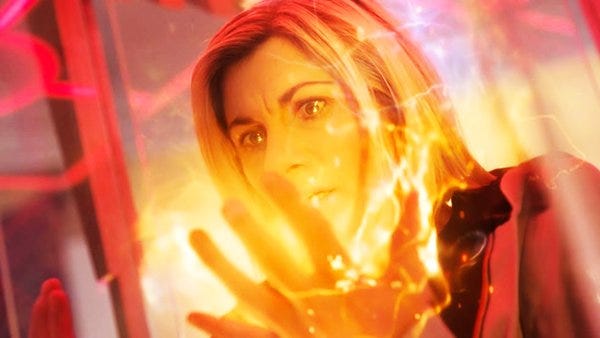
4. Lucky Thirteen?
What, you might wonder, could possibly be worse than the Master, the Cybermen, and the Daleks uniting their efforts to cause trouble for the Doctor, the Earth, and humanity itself? Considering how many terrible schemes the Master/Missy has pursued during his/her epoch-making, endless feud with the Doctor (ever since Roger Delgado originated the Master in Classic Who’s 1971 four-part serial Terror of the Autons), could any new plan outdo what’s come before? Chibnall, having thought long and hard about this question, builds upon the answer that Russell T. Davies provides in “The End of Time,” the incredible, batty, two-part swan song for David’s Tennant’s Tenth Doctor that Davies unleashed upon the world during the Christmas 2009/New Year’s 2010 holiday.
In that adventure, the Master (John Simm) seizes an extraterrestrial medical device called the Immortality Gate to imprint his genetic structure into every human being, which produces the astonishing spectacle of the Simm Master grinning, laughing, and rejoicing over the fact that he now inhabits the body of every person on Earth, thereby depriving the Tenth Doctor of his favorite non-Gallifreyan species and making every single person—meaning every one of us—into the Master.
Yes, it’s wacky, it’s loopy, and it’s crackers, but, thanks to Simm’s wonderful performance(s) as seven billion people worldwide, this plot’s implications are both chilling and monstrous to consider. The tonal paradox that Davies captures in “The End of Time” allows its viewers to enjoy the Master destroying humanity—literally and figuratively—in one of the gloomiest holiday specials New Who’s ever produced. Yet, thanks to Davies’s and the Tenth Doctor’s brio, “The End of Time” emerges as a joyful celebration of the human spirit.
Chibnall strives to re-create this insanity in “The Power of the Doctor” by having the Master deface 15 famous paintings and slaughter 12 seismologists to draw the Thirteenth Doctor into his trap, which, when sprung, is staggering to behold. The Daleks capture Thirteen when she visits the interior of a Bolivian volcano that these extraterrestrial pepper-pots are altering to increase the strength of its forthcoming eruption. The Daleks then whisk the Thirteenth Doctor to the Romanovs’ Winter Palace in the year 1916, where the Rasputin Master has prepared two glass chambers that recall the glass Immortality Gate compartments that spell the Tenth Doctor’s downfall in “The End of Time.”
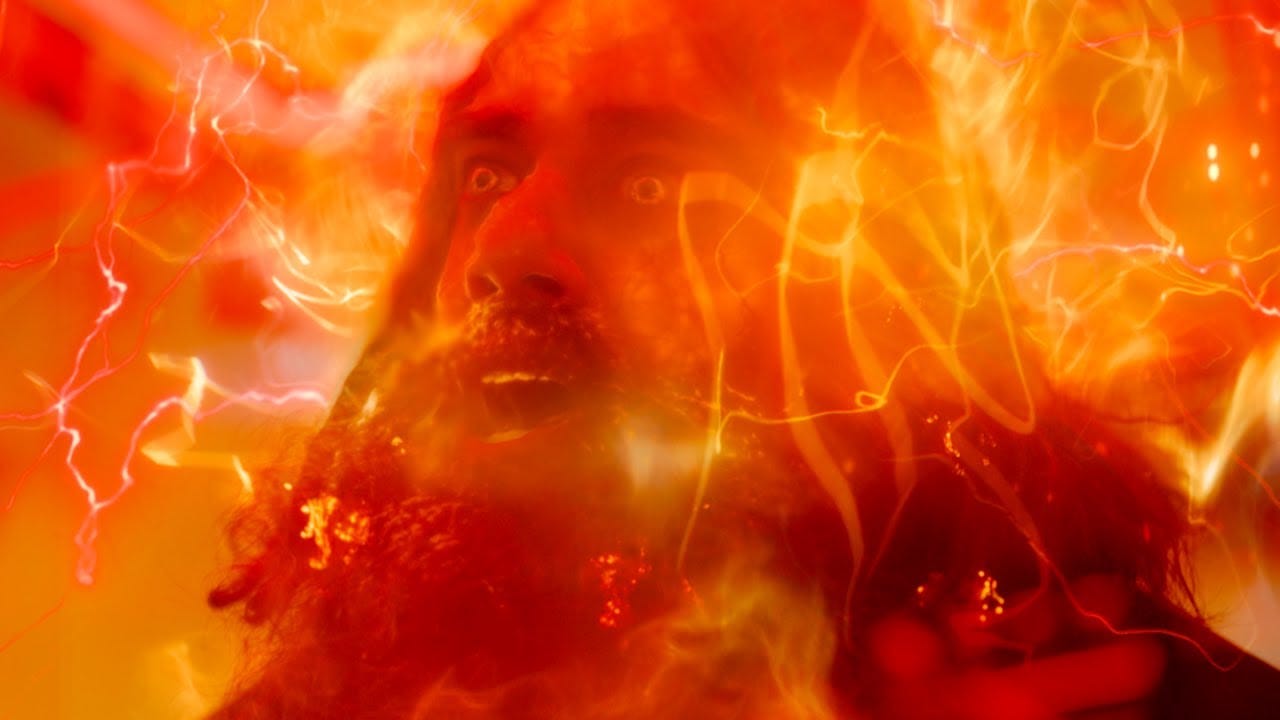
This setup, however, presages the most calamitous event ever chronicled in Doctor Who when the Rasputin Master, after securing Thirteen in one of these chambers, reveals—and please forgive this pun—his master plan: to force regeneration onto the Thirteenth Doctor, but not just any regeneration, for the Master vows to regenerate himself into Thirteen. He intends to usurp her life, steal her identity and, as he says, erase the Thirteenth Doctor’s existence. Chris Chibnall here one-ups Russell T. Davies by taking the notion of the Master imprinting himself into another being’s genetic structure to its—dare we say it?—logical limit. The Master, after finally commandeering the Doctor’s body, vows to rewrite her legacy of compassion, exploration, and wonder into a palimpsest of cruelty, pain, and destruction.
TILT! BANG! BOOM! CRASH! Yes, friends, the moment when, after coruscating waves of regeneration energy overtake Thirteen’s body, the Master appears wearing her clothes is the instant “The Power of the Doctor” goes beyond Crazy Town, leaps off the Cliffs of Insanity, and enters territory with no suitable label or nickname. This move’s implications are too mind-bending to summarize even in a review as lengthy as this one, but, dear reader, please know that I jumped off my couch and screamed at the television screen, “No! No! What?! It can’t be! Can it?! No! No! What the fu—?!”
No words can express how astonished I was that Chibnall pressed “The Power of the Doctor” so far beyond what he’d done with the Timeless Child storyline. Even now, I’m amazed that Chibnall includes forced regeneration in his final episode as New Who’s captain no matter how many nagging voices (from the network’s gatekeepers, from the fans’ imagined responses, from whatever impulses compete for primacy in Chibnall’s head when he’s writing a script, and, for all I know, from the cast and crew, too) assaulted him when envisaging this remarkable development.
That’s drama, folks!
That’s entertainment!
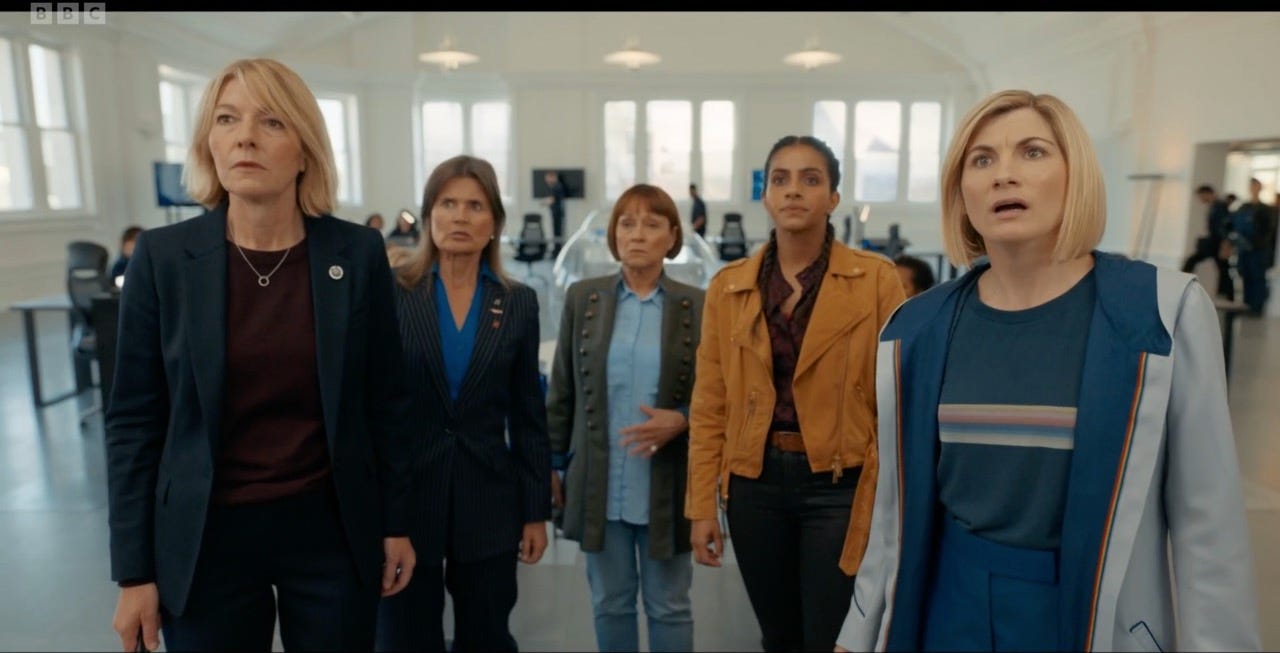
5. Women of the World, Unite
Only the 1996 television movie (titled, simply, Doctor Who) that introduced Paul McGann’s marvelous Eighth Doctor to the franchise ever contemplated a similar onscreen premise, wherein the Master, played by a flamboyantly menacing Eric Roberts, tries to absorb the Doctor’s remaining regenerations, or, put another way, tries to steal the Doctor’s life essence. Despite the Roberts Master’s best-laid plans, the Eighth Doctor and his TV movie companion, Dr. Grace Holloway (Daphne Ashbrook), manage to outsmart him, meaning that even this production—eccentric as it is—fails to make good on its premise. Despite teasing the possibility of the Master becoming the Doctor, the TV movie concludes as conventionally as one expects—with the Eighth Doctor safe and sound—to stand as a fascinating, well-acted, yet traditional entry in Doctor Who’s long-running story.
Chris Chibnall, by contrast, can’t be accused of bowing to convention in “The Power of the Doctor.” By plunging this episode into chaos, he doesn’t seem to mind the dangerous implications of seeing Sacha Dhawan wearing Jodie Whittaker’s costume—or, stated more accurately, of the male Master displacing the first female Doctor in her last go-round as Doctor Who’s protagonist—implications that began nipping at the back of my mind once I returned to my seat, and my senses, after the devastating spectacle of the Thirteenth Doctor’s forced regeneration. How, after all, could Chibnall—in truth, how could anyone—follow up this event? Isn’t this plot twist’s sheer flash/whiz/bang-itis too much to top?
“Yes” is the short answer, but no matter how brave a dramatic decision regenerating the Thirteenth Doctor into the Master may be, so many questions arise that compiling them all would take hours, even days, to complete. Chief among them: Doesn’t pushing Thirteen aside so the Master can prance about in her clothes—before donning a new costume combining elements of many previous Doctors’ clothing (the Second Doctor’s recorder, the Fourth Doctor’s multicolored scarf, the Fifth Doctor’s lapel-pinned celery stick, the Seventh Doctor’s question-mark jumper, the Tenth Doctor’s tie, the Twelfth Doctor’s plaid pants, and the Thirteenth Doctor’s blue coat)—devalue, if not belittle, Jodie Whittaker’s history-making turn as Doctor Who’s star?
This disturbing prospect is, let’s face it, one of the Chibnall era’s most objectionable trends. His episodes frequently feature fantastic women—the Thirteenth Doctor and Yaz foremost among them—pursuing fantastic accomplishments that their storylines promptly undercut by shuffling these achievements offscreen, almost as if Chibnall and his writing staff hope that Thirteen can escape the complaints of those misogynistic trolls who’ve objected to the Doctor being a woman since Whittaker’s casting was announced on 16 July 2017 (and who’ll never stop crying about how terrible they think the reality of a female Doctor is no matter what Chibnall, Whittaker, and their writers do).
Why not, then, revel in the fact that the Thirteenth Doctor and her chief companion are fabulous women—yes, friends, women—not “characters who happen to be women,” to employ the ramblings of commentators so disturbed by some of their fellow watchers openly expressing sexist attitudes against Thirteen that these same observers dilute her influence as the central character of the BBC’s flagship drama, even claiming that the Thirteenth Doctor’s gender is, if not inconsequential, then certainly less important than her other qualities (whatever they are), because, after all, if gender doesn’t matter to the Doctor, why should it concern audience members?
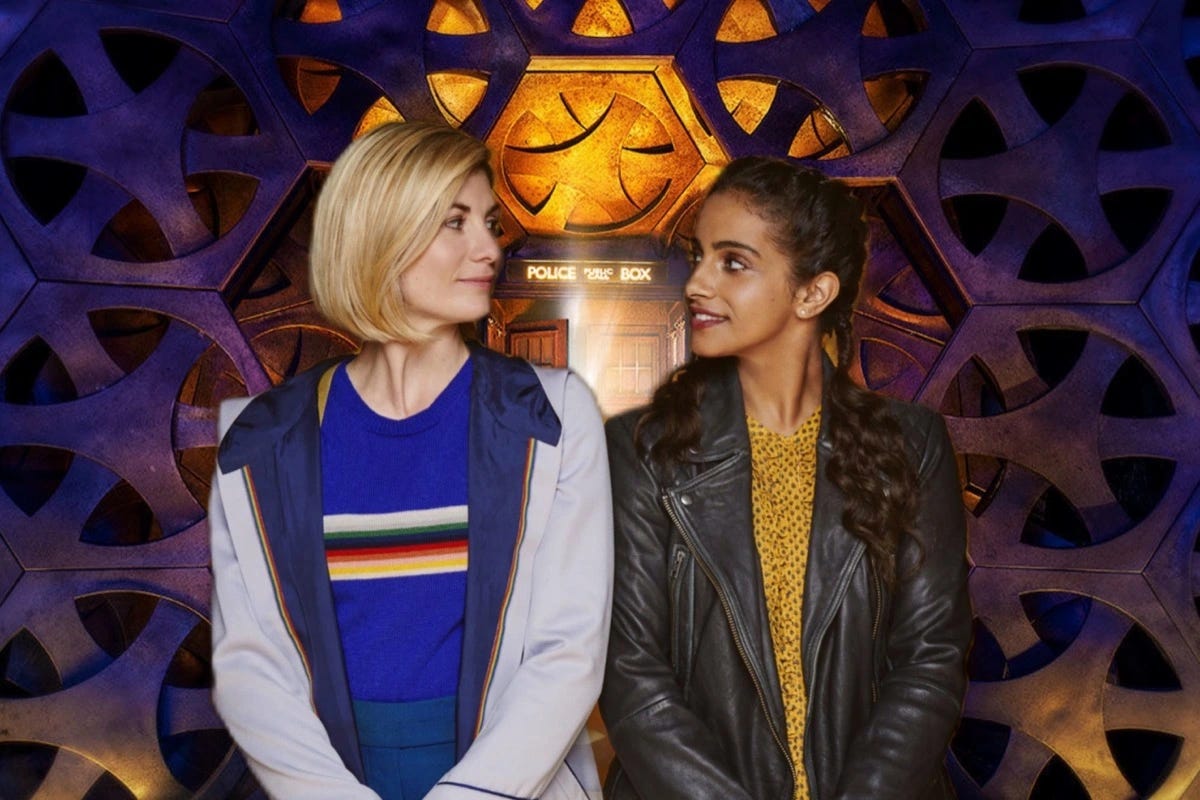
Except that, in the real world, these issues do matter, meaning that milquetoast responses to the bigotry the Thirteenth Doctor’s faced during her TARDIS tenure surrender ground to the same regressive forces they claim to combat. Chibnall at his worst follows this path, while, at his best, ignores (or, as we intellectuals prefer to say, doesn’t give a shit about) those haters who never have—and never will—give the Thirteenth Doctor or Jodie Whittaker any credit. Let’s therefore be grateful that not even Chibnall’s worst authorial habits can diminish the legitimate achievements he and his production team have accrued by casting Whittaker as the Doctor and giving her marvelous material to play.
And “The Power of the Doctor” gives Whittaker plenty of good material, particularly after the Master’s forced regeneration pushes the Thirteenth Doctor into a mystical quasi-space where, similar to being “trisected” during the Flux finale (“The Vanquishers”), Thirteen must fight for her life—confined to the sidelines and temporarily out of the struggle—while her male nemesis effects terrible changes in the real world.
These jumbled gender dynamics typify Chibnall’s groundbreaking New Who era, diluting its highs and accentuating its lows, so perhaps it’s right and proper that his final episode as showrunner bundles all these contradictions into a single adventure. No matter how good parts of this installment may be (and whole swathes are very good indeed), “The Power of the Doctor” can’t resolve these complications no matter how hard Chibnall tries.
I’m unsure if a female showrunner would’ve handled these issues better than Chibnall (Steven Moffat wouldn’t have, but Russell T. Davies might have), making the Thirteenth Doctor’s forced regeneration a brilliant notion that Chibnall doesn’t fully think through despite the good drama it generates. This judgment also handily describes Chibnall’s strengths and weaknesses as Doctor Who’s chief writer, so, perhaps if the Centenary Special’s story extended over a longer span (say, a six-episode serial like Flux or, even better, a full season of 13 installments), it might offer more satisfying responses to the questions, issues, and controversies it raises.
Instead, Chibnall gives us a fizzing, sizzling, jam-packed sprint through decades of Doctor Who’s history that, while unable to fulfill its lofty—even exalted—ambitions, still elicits so much thought and passion about its narrative repercussions that the criticisms lodged here can’t stop me from recommending “The Power of the Doctor” to all comers. How, indeed, could I not endorse a segment that—bubbling with ideas, themes, and symbols—impeccably synopsizes Chibnall’s take on Doctor Who?
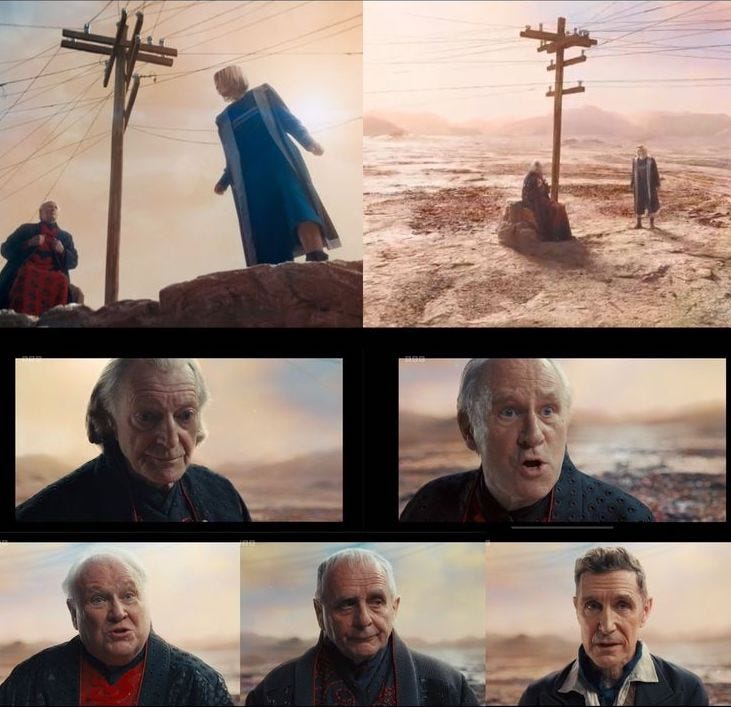
6. Doctors Who?
“Fizzing, sizzling, and jam-packed” also describes Sacha Dhawan’s rage-filled performance as the Master, who’s rarely been as unhinged as he is in “The Power of the Doctor.” Despite retaining the charm every incarnation of this character exhibits throughout the Who franchise, the Dhawan Master’s mood ranges from patient mesmerism (when he playacts Rasputin) to withering mockery (when he’s captured by UNIT soldiers, who unwisely take him to their new London headquarters building, where he mercilessly needles Ace and Tegan) to blazing contempt (whenever he interacts with the Thirteenth Doctor and, after regenerating into Thirteen, with Yaz, who, during more than one outburst, looks shocked by his ferocity).
Plus, Dhawan clearly loves his character’s silliest scene, an absurdist masterpiece that sees the Rasputin Master, right before he enters the conversion chamber that’ll regenerate him into Thirteen, dance to Boney M.’s 1978 pop hit “Rasputin” (the Majestic remix, according to Chibnall’s script)4 in a display that must be experienced to be believed.
The Cybermen and Daleks can’t quite conceive what they’re seeing or hearing, either. And, upon first viewing, neither could I, nor can I now decide if Chibnall adopts the most obvious imaginable ploy—having the Master groove to the most famous song ever recorded about Russia’s most famous mystic—or, alternatively, if Chibnall demonstrates great courage by going where most of us watching at home thought he’d never go because including Boney M.’s “Rasputin” in an installment where the Master impersonates said mystic is just where we’d expect Chibnall to travel.
Either way, Sacha Dhawan hilariously spins, sways, and sashays his way through this imbroglio to lighten the mood just before the Master force-regenerates himself into the Doctor and becomes what Chibnall’s teleplay calls “the Master-Doctor.”5 How, we now wonder, can Thirteen reverse this process? As excellent as Dhawan is throughout “The Power of the Doctor,” it’s left to Jodie Whittaker and Mandip Gill to evoke the many poignant emotions this installment unveils in its final 40 minutes, with Yaz Khan becoming a hero(ine) for the ages by taking command of the TARDIS to save her best friend from the terrible fate to which the Master consigns her.
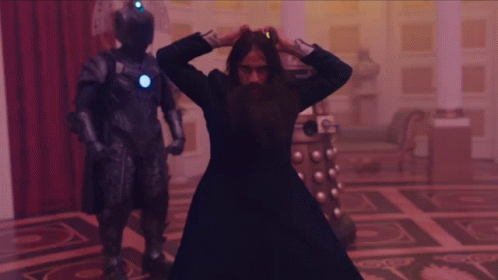
Thirteen, who’s always gotten by with a little help from her friends, awakens at a barren desert crossroads to find a robed figure sitting atop a rock located next to a single power-line pole (get it?). When the camera reveals the First Doctor (played here, as in the Twelfth Doctor’s swan song, 2017’s “Twice Upon a Time,” by David Bradley) commenting, “Well, you’re obviously one of the more determined of us,” composer Segun Akinola’s exquisite “Thirteenth Doctor’s Theme” accompanies a cycle in which Colin Baker’s Sixth Doctor, then Peter Davison’s Fifth Doctor, then Paul McGann’s Eighth Doctor, and finally Sylvester McCoy’s Seventh Doctor tell Thirteen that the place she now inhabits—referred to in Chibnall’s script as an “endless mindscape”6—is where the Doctor goes while regenerating.
I squeed with glee during this sequence, to which every performer brings her or his A-game. Discounting the 1993 Children in Need special Dimensions in Time (that served as Doctor Who’s 30th Anniversary Special), 2013’s mischievous 50th Anniversary mini-special The Five(ish) Doctors Reboot, and various stock-footage appearances throughout the revival series, Baker returns to televised Who as the Sixth Doctor for the first time in nearly 36 years (i.e., since 6 December 1986’s broadcast of The Ultimate Foe, the last of four serials in Season 23’s The Trial of a Time Lord), McCoy performs the Seventh Doctor 26 years after his final live-action appearance in 1996’s Doctor Who television movie, Davison embodies the Fifth Doctor 15 years after 2007’s Children in Need special “Time Crash” (the delightful New Who “mini-sode” written by Steven Moffat that co-stars David Tennant as the Tenth Doctor), and McGann again becomes the Eighth Doctor nine years after 2013’s “The Night of the Doctor” (the 50th Anniversary mini-sode, also scripted by Moffat, that sees the Eighth Doctor die, get revived by the Sisterhood of Karn, and regenerate into John Hurt’s War Doctor).7
They are, individually and collectively, superb, with the Seventh and the Eighth Doctors—cribbing from McCoy’s and McGann’s real-life friendship—bickering over Eight’s refusal to wear Gallifreyan robes. These vestiges of the Thirteenth Doctor’s consciousness are what Eight calls “the Guardians of the Edge,” remnants of the Doctor’s past who protect their mutual existence by ensuring a smooth transition from one incarnation to the next. Allowing the Master to hijack this process will spell doom, with the term edge referring to the boundary between everlasting life and permanent death symbolized by a nearby cliff that plunges to infinity (and that recalls the precipice bisecting the English village of Medderton in Flux’s best episode, its fourth, titled “Village of the Angels”).
Thirteen’s resilience, while inspiring, requires external assistance from Yaz, who drives herself, Ace, Tegan, Kate Lethbridge-Stewart, and returning Flux companion Inston Vee-Vinder (Jacob Anderson) to oppose the Master-Doctor’s plan at every turn. Yaz pushes the Master-Doctor out the TARDIS’s door after he lands the timeship on an alien moon that permits him to observe two planets destroying one another with space missiles (in a war that he’s engineered in the name of the Doctor). Yaz then pilots the TARDIS away, retrieving Vinder from the 1916 Cybermoon, where his spacecraft has crashed while Vinder searches for a Qurunx, the fabled sentient-energy creature that the CyberMasters, in “The Power of the Doctor’s” opening sequence, abduct from the bullet train rushing through outer space.
Perhaps the best part of Yaz’s devotion to Thirteen is how it matches the warm feelings that Ace and Tegan share for their Gallifreyan friend, who, early in “The Power of the Doctor,” inserts what she calls “nano-implants” into all three women’s skin that transmit an “interactive AI holo-me built from data of my behavior across thousands of years” to help them defeat the CyberMasters, the Daleks, and the Master. These devices allow Five, Seven, and Thirteen to chat with their respective companions, thereby revitalizing the notion of a holographic Doctor first seen in Series 1’s finale, “The Parting of the Ways,” when a flickering Ninth Doctor projection encourages Billie Piper’s Rose Tyler to “have a fantastic life” after saving her from a massive (and relentless) Dalek attack.
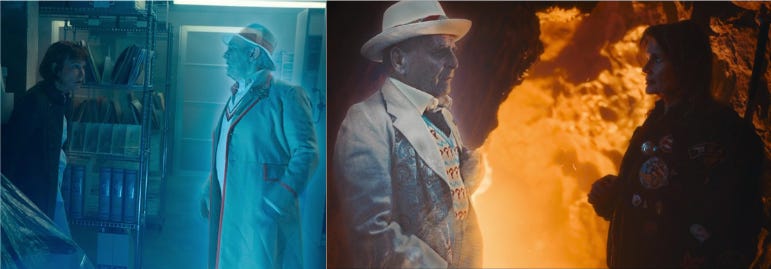
Ace and Tegan, as a result, get one final conversation with the Doctor they knew and loved. Tegan, making her way into the basement of UNIT’s headquarters during a Cyberman takeover of the building, is startled to see the Thirteenth Doctor’s hologram arrive to assist her, but even more surprised when Thirteen’s image fritzes into the Fifth Doctor.
Tegan’s unresolved feelings about Five’s abandonment, we’re told, cause her to see him rather than Thirteen, but this technobabble isn’t nearly as satisfying as watching these two friends chat for the first time in decades. Peter Davison and Janet Fielding are so touching here, joking with one another about their aged appearances, that, when Five mentions the death of Classic Who companion Adric (Matthew Waterhouse), the young man who sacrifices himself to save the TARDIS while fighting Cybermen in the 1982 serial Earthshock, the Fifth Doctor’s sadness at this loss leads him to tell Tegan, in dialogue movingly uttered by Davison, “You think you left and I never thought of you again. I never forget any of you. I remember everything.”
Recognizing how much Tegan and Five have lost—and how much they love one other—packs a tremendous emotional wallop (confession: my eyes were wet). So, too, does the later conversation between Ace and a holographic Seventh Doctor, where Seven regrets failing to teach Ace (who, remember, was only a teenager during their travels) good habits. Yet, when Ace replies, “You never failed me, Professor. You made me the person I am today,” Seven smiles in that wonderfully elegiac way Sylvester McCoy long ago patented.
When the Seventh Doctor observes, “All children leave home sooner or later. The joy is to watch them fly,” the delight that overtakes Ace’s face is a tribute to Sophie Aldred’s talent and skill. I couldn’t contain a few more sobs when, after Ace asks Seven, “So we’re good?,” he tells her, his Scottish burr trilling the R’s just like we remember, “Oh, we’re more than good. We’re ace.”
Chibnall grants Classic Who fans (and New Who fans, too) real catharsis here, demonstrating how tremendous a writer he can be. Finding a clever way to save Thirteen’s life now becomes his quest, so Chibnall, in perhaps my favorite moment of the entire Centenary Special, invites one final visitor to make an entrance so grand I couldn’t help leaping to my feet and cheering yet again.
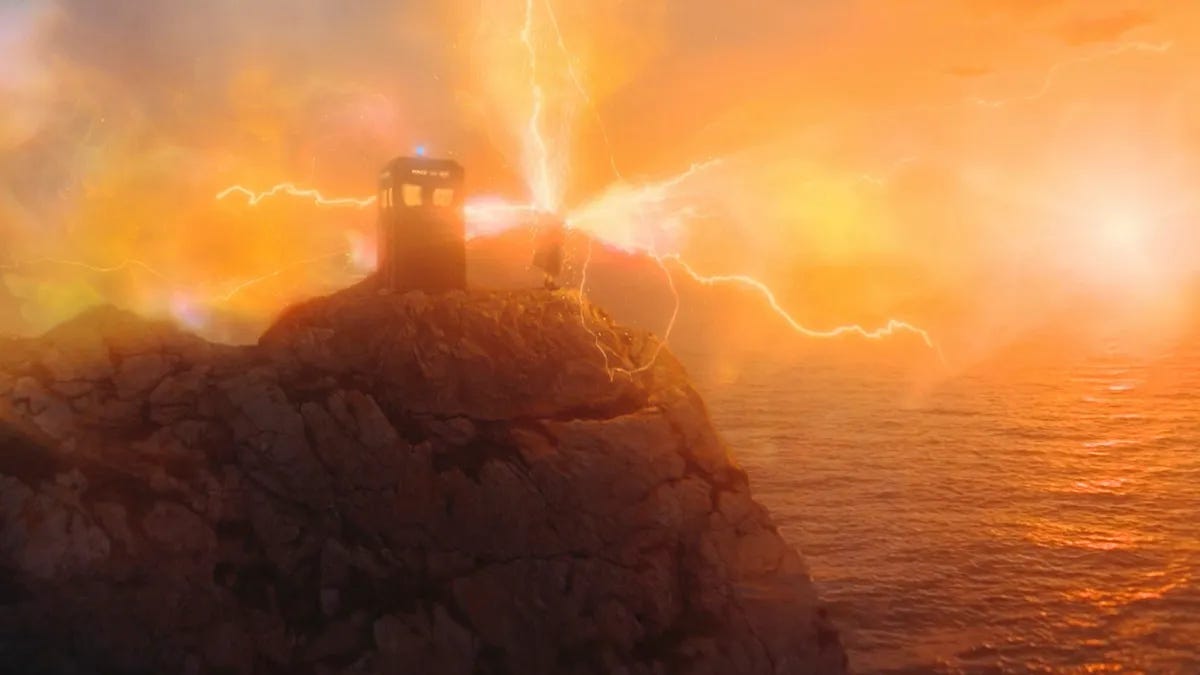
7. Blossomiest Blossoms
And what a triumphant moment it is when Jo Martin’s tremendous Fugitive Doctor strides into the Winter Palace rotunda where the Master’s forced-regeneration chamber resides.
Yaz, knowing that the Master-Doctor can’t resist preening about his apparent victory over Thirteen, returns the TARDIS to him and plays the role of chastened sidekick to lure him into a final snare that he doesn’t see coming. Revisiting the Winter Palace (circa 1916), the Master continues his plot to transform Earth into a global foundry that will equip the Cybermen and the Daleks with enough ships and weapons to conquer the universe, just as the Simm Master does in Russell T. Davies’s epic, multipart Series 3 finale “Utopia” / “The Sound of Drums” / “Last of the Time Lords.” The Fugitive Doctor, however, isn’t impressed by the Dhawan Master or his scheme, telling him, after he wonders who she is, “I’m the Doctor, mate. Who the hell are you?”
Oh, I crowed aloud to hear Jo Martin deliver these lines with the unimpeachable authority that’s made her a fabulous franchise addition. The CyberMasters form a ring around the Fugitive Doctor, then shoot themselves dead by firing directly through her—yes, friends, she’s a hologram—in a smaller-scale version of the climax of “The Day of the Doctor,” where the Daleks, while blasting Gallifrey with their orbiting lasers, can only fire on one another after the Tenth, Eleventh, and War Doctors send the planet into a parallel pocket universe that leaves the Daleks no target but themselves.
Then, as the CyberMasters begin regenerating, Yaz and Vinder compel the Master back into the glass chamber where he stole the Thirteenth Doctor’s life. Waves of roiling, amber energy radiate from the CyberMasters and, thankfully, reverse Thirteen’s forced regeneration (or, perhaps, degeneration is the better term). When she explodes back into her own body (read that last bit again and tell me Doctor Who isn’t the daftest, most enchanting nonsense ever imagined for the screen), Thirteen affirms just how correct Yaz is to tell the Master, right before he’s dispatched, “You’re not my Doctor! ‘Cause you know the greatest strength my Doctor has? She’s spent her life gathering friends. She can’t help it. And she is loved.”
Mandip Gill couldn’t be better here if she tried. So good is she that “The Power of the Doctor” should’ve revolved around Yaz no matter how nice seeing Classic Who characters alongside New Who returnees (like Bradley Walsh’s Graham O’Brien, who helps Ace defeat the Daleks inside an erupting Bolivian volcano) may be. Chibnall, perhaps realizing this deficiency, makes Yaz the Thirteenth Doctor’s savior a second time when, after Thirteen solves all but one of the episode’s remaining crises, her “extended fam” works the TARDIS’s controls in a cheerful callback to the Series 4 finale, “Journey’s End,” where seven of the Tenth Doctor’s companions stage an exuberant TARDIS-flying scene that provides the template for the equally boisterous companion-fest seen in “The Power of the Doctor.”
Returning to the Master’s Cybermoon, the Doctor frees the Qurunx after asking it to destroy this metal-encrusted orb. All seems well, with “The Power of the Doctor” racing toward its conclusion, but, in perhaps this installment’s greatest irony, the Doctor’s refusal to kill the Master proves fatal. Resuming his old, dying body after undergoing degeneration, the Dhawan Master teleports to the Cybermoon just as the Qurunx begins annihilating the satellite’s surface and, in his last act, employs a mechanism that controls the Qurunx’s movements to redirect the creature’s energy beams onto Thirteen.
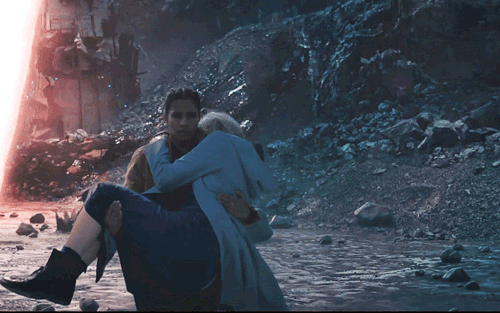
Yaz rushes from the TARDIS, picks up her fallen comrade, and walks toward the timeship’s open doorway in what Chibnall’s teleplay calls an “ICONIC HERO SLO-MO WIDE” shot.8 This sequence is marvelous, with Segun Akinola’s score splendidly accentuating Yaz’s gallantry, but the Thirteenth Doctor hasn’t long to live. She collapses into unconsciousness, giving Yaz time to drop everyone else off in Croydon (in yet another Classic Who allusion, this time to the 1976 serial The Hand of Fear, where the Fourth Doctor accidentally leaves the departing Sarah Jane Smith in Aberdeen, Scotland rather than her South Croydon home). When Thirteen awakens, her right hand glows with regenerative energy.
Chibnall now melds bits and pieces of the Ninth, Tenth, Eleventh, and Twelfth Doctors’ exits into Thirteen’s last scenes. She comforts Yaz about the forthcoming change (just as Nine reassures Rose Tyler about his impending regeneration in Series 1’s “The Parting of the Ways”), expresses her desire for more life (similar to Ten in “The End of Time,” although Thirteen reformats his last words “I don’t want to go” into “I need more time. I want more time”), declares how much she’s enjoyed being the Doctor (recalling Eleven’s promise, in Series 7’s 2013 Christmas Special “The Time of the Doctor,” to “always remember when the Doctor was me”), and announces that she must “do this next bit alone” (just as the Twelfth Doctor, in 2017’s “Twice Upon a Time,” states “what happens now, where I go now, it has to be alone” as his transition begins). Thirteen then puts her own gentle spin on this tradition by chatting with Yaz while they sit atop the TARDIS eating ice-cream cones and gazing at the magisterial beauty of Planet Earth as it hangs in space in front of them.
When Yaz says, “I don’t want it to end” and “let’s not say goodbye,” some fans might expect Thirteen to confess romantic feelings for—or even kiss—Yaz, who, during her time on the TARDIS, has fallen in love with the Doctor. This possibility implicates another well-established New Who convention, with faithful viewers remembering how Rose Tyler falls for the Tenth Doctor in Series 2. Yaz’s feelings, however, mimic Martha Jones’s unrequited affection for Ten in Series 3, an uncomfortable reminder that Doctor Who’s racial undercurrents can be as choppy as its gender dynamics since the program’s showrunners seem not to know how to handle (or, at least, don’t know how to handle well) characters of color expressing their love for the Doctor.
To add fuel to this fire, some commentators have accused Chibnall of queerbaiting Yaz, a charge with more ammunition than I’d prefer to acknowledge. We must, however, always hold the cultural productions we value accountable for their deficiencies, meaning that the visual and emotional splendor of Thirteen’s final passage cannot handwave away these concerns.
Although Thirteen explains to Yaz in the prior episode, the Easter 2022 Special “Legend of the Sea Devils,” why she now avoids romantic attachments, hearing the Doctor say, “I have loved being with you, Yaz. And I have loved being me” at the culmination of their relationship brings “The Power of the Doctor” to the brink of a love confession that fans of Chibnall’s era may desire, but that the Thirteenth Doctor—as nice and kind a person as the Twelfth Doctor advises her to be in his final “Twice Upon a Time” monologue—can’t cross without giving Yaz false hope.
These delicate feelings are complicated to navigate, but Jodie Whittaker’s open-hearted goodness fuses optimism with regret and happiness with melancholy to make the Doctor’s and Yaz’s waning moments together wistful, gentle, and inspirational. What a pleasure it is hearing Thirteen tell Yaz, “A wise person once said to me, ‘Goodbyes only hurt because what came before was so special.’ Oh, and it’s been so special. You and Graham and Ryan and Dan: nobody else got to be us. Nobody else got to live our days. Nobody. And my hearts are so full of love of all of you.” Such good words—scratch that, wonderful words—inspire Whittaker to a performance of heart-crushing and soul-stirring beauty.
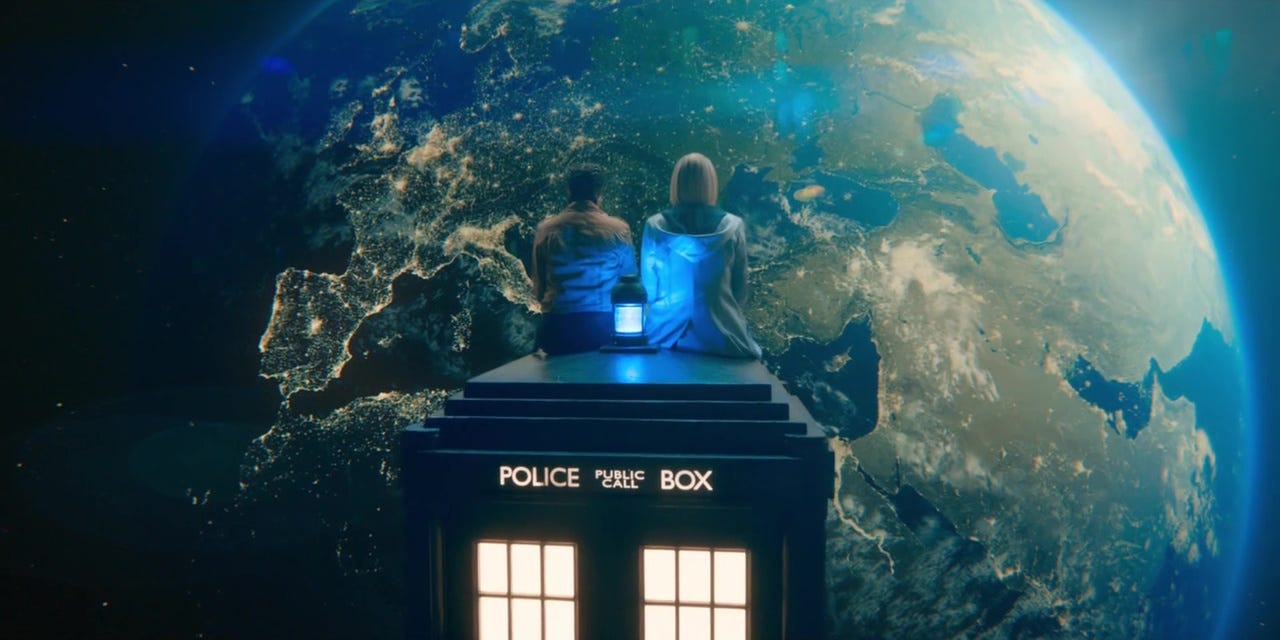
Mandip Gill is tremendous here, glancing at the Doctor when she (Yaz) isn’t holding back tears. Yaz maintains a brave face, so not seeing her kiss the Doctor seems correct in the moment even if Chris Chibnall, in the WHO Corner to Corner podcast’s 17 September 2023 episode, remains unsure about forestalling this gesture. “I think it’s an unrequited love story,” Chibnall says when the topic of the Doctor’s and Yaz’s relationship arises: “I don’t know whether that’s the right decision, you know?”
Chibnall then reveals that he and his writing staff thought not seeing these characters kiss was more emotionally powerful: “There wasn’t any sense of ‘they’re not allowed to kiss’ or ‘they’re not going to kiss.’ Dramatically, emotionally, it felt slightly more wrenching if they didn’t. And also, I think if they kiss, you don’t get the final scene on top of the TARDIS because that scene was always sort of the kiss, really.”9
This perspective has merit, as do the observations of the people who criticize it. The entire sequence’s ambivalence oscillates between profoundly restrained emotions and a dissatisfying surrender to heteronormative conventions that undercuts, if it doesn’t fully sell out, Yaz’s queer identity. “The Power of the Doctor” can’t provide definitive answers, so it simply moves on, with the Doctor dropping off Yaz in a public park.
Their final exchange—a silent gaze—is surprisingly unfussy and short. Graham and Dan then walk up to Yaz and invite her to a support group for former companions that unites additional characters (and actors) from across the franchise. Chinball here provides a masterclass in nostalgia that hits all the right notes: Yaz, Dan, Graham, Ace, Tegan, and Kate join Katy Manning’s Jo Jones (who travelled with the Third Doctor), Bonnie Langford’s Melanie Bush (who travelled with the Sixth and Seventh Doctors), and, in a tremendous coup, William Russell’s Ian Chesterton, who first appeared in 1963’s “The Unearthly Child” and who asks Dan, in a charming moment, “Sorry, did you say her?” after learning the Doctor is now a woman.
Russell, by appearing in “The Power of the Doctor,” sets the Guinness World Record for the longest gap between television appearances by a single actor in the same role, turning up 57 years and 120 days after his final episode (“The Planet of Decision”) in Season 2’s serial The Chase aired on 26 June 1965.10 Amazing, yes, but, as gratifying as spending time with Ian and company is, the most crucial event of every Doctor’s final journey now awaits: regeneration.
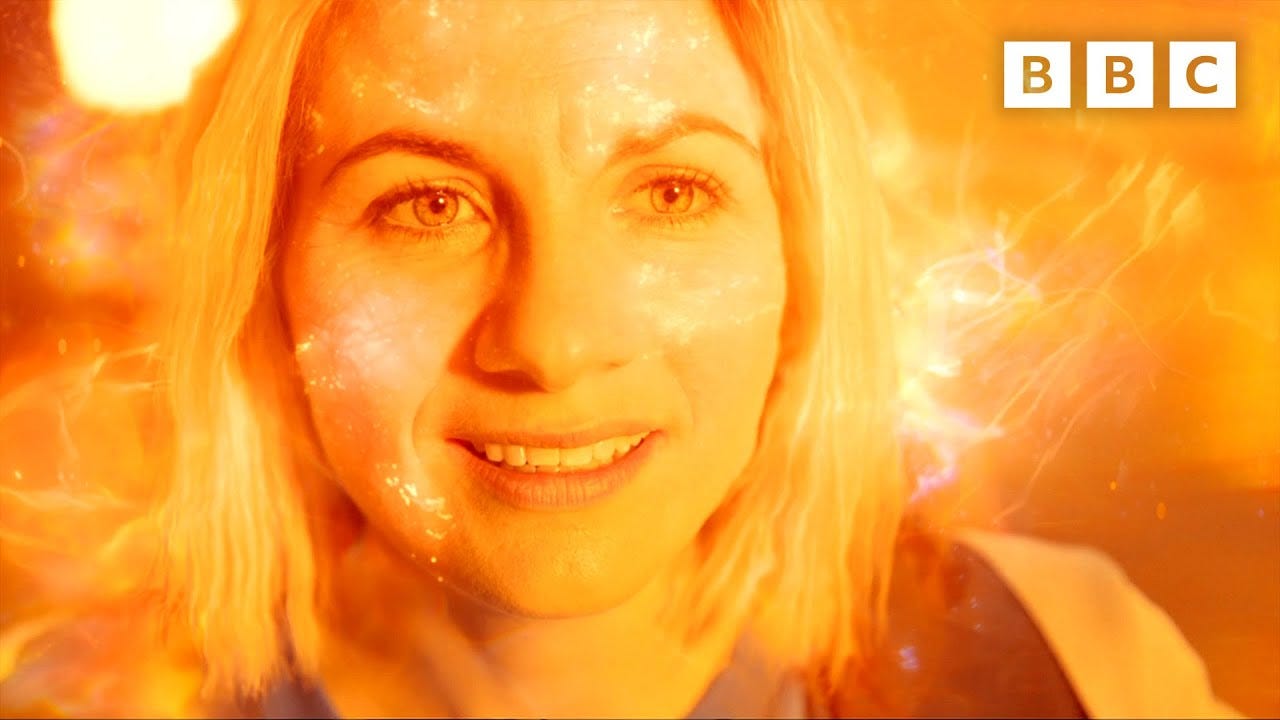
Jodie Whittaker, Chris Chibnall, composer Segun Akinola, director Jamie Magnus Stone, and the production team deliver beyond all expectations here. The Thirteenth Doctor heeds her four predecessors’ major lesson, namely don’t regenerate inside the TARDIS lest it explode and/or crash, by landing on Durdle Door, the famous limestone arch located on England’s Dorset coast. Telling the TARDIS, “look after the next one,” Thirteen walks outside to enjoy “one last sunrise.”
Smiling almost as brightly as the morning sunshine, the Thirteenth Doctor inhales Durdle Door’s fresh air, then says, speaking to the next Doctor, “Oh, the blossomiest blossom. That’s the only sad thing. I wanna know what happens next. ‘Right then, Doctor Whoever-I’m-About-To-Be: Tag, you’re it.”
These sweet parting words perfectly evoke Thirteen’s optimistic, heroic, joyous approach to life. She looks to her future, to her next adventure, and to her next incarnation in tranquility, in peace, and in harmony with everything around her.
Oh, it’s glorious, with regeneration energy bleeding into the morning light while the “Thirteenth Doctor’s Theme” rises to spine-tingling heights. What a monumental sequence and what a superb performance to conclude Jodie Whittaker’s tenure as the Doctor. They overcome nearly all the flaws discussed above to leave us, or, at least, to leave me on an emotional pinnacle that’s impossible to forget.

8. What? What?! What?!
Then the strangest thing happens.
Unlike all previous New Who regenerations, the Thirteenth Doctor’s clothes change along with her body to reveal the Tenth Doctor’s familiar, shocked face. “I know these teeth,” the New Doctor says, examining his hands and his costume before uttering one of Ten’s best taglines: “What? What?! What?!”
These words were scripted by incoming showrunner Russell T. Davies with an assist from David Tennant,11 whose brief appearance raises many questions about how a previous incarnation can return, about why the show reverts to tradition rather than casting another female Doctor, and about when we’ll see Ncuti Gatwa’s Fourteenth Doctor onscreen.
Except that, according to Davies, Tennant was hired to play the Fourteenth Doctor (not the Tenth), making Gatwa’s version, when he finally appears sometime during the 60th Anniversary Year of 2023, the Fifteenth Doctor.12 So fun (and thrilling) times lie ahead, but let’s not speculate too much about that future, which only detracts from the Thirteenth Doctor’s stunning departure.
This supersized, longest-ever Vestibule review proves there’s so much to say about “The Power of the Doctor” that the words come pouring out like water gushing from an unplugged firehose. “The Power of the Doctor” is, in the end, so rich and barmy and wonderful an experience that I could talk about it forever.
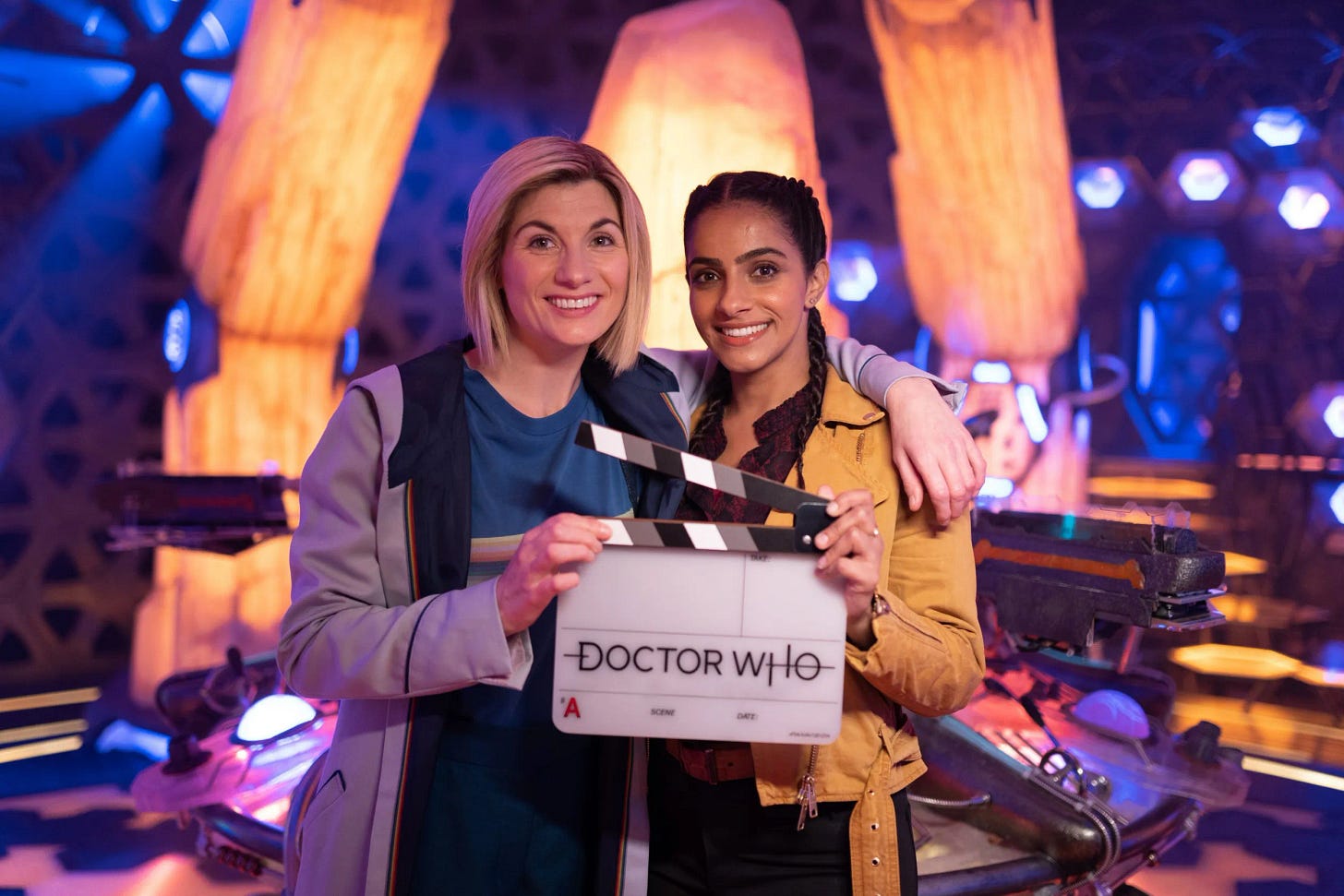
Yet here, at the last, I wish to praise Chris Chibnall and his creative team for awarding us one of the best Doctors in Doctor Who’s history. Chibnall’s era wasn’t always the smoothest ride, but I’m better for having experienced it. Like the Thirteenth Doctor, I’m bursting with happy feelings about what’s gone before and excited to see what happens next.
That’s an extraordinary response for any text to provoke, so I reserve my final words for the two people most responsible for making this era of Doctor Who so good that I wish it could go on forever.
Thank you, Mandip Gill and Jodie Whittaker.
You were brilliant.
Farewell, Yaz Khan and Doctor Thirteen.
You’ll be missed.
And amen.
FILE
NOTES
Chris Chibnall, Doctor Who 13.9: “The Power of the Doctor,” Centenary Special, undated teleplay draft, pg. 9.
Please find Chibnall’s teleplay on the BBC Writers’ Room Script Library page (at www.bbc.co.uk/writersroom/documents/doctor-who-the-power-of-the-doctor-chris-chibnall.pdf).
Baker has discussed the Sixth Doctor’s costume many times over the decades, in response to fans’ questions and journalists’ queries, always with good cheer and ingratiating humility.
Telling Lauren Faits (of the website Geek Girl Chicago) during an interview conducted at December 2013’s Chicago TARDIS convention that he wanted dark clothing similar to Christopher Eccleston’s Ninth Doctor costume (as seen in New Who’s first revival series), Baker notes, “you can lurk in the background and achieve things you can’t achieve when you go around looking like an explosion in a rainbow factory! It’s just absurd, but it’s a reflection of the time. It was 1983, it was glam rock and all that was going on. . . .”
See Faits’s “The Bitter and the Sweet Sixth Doctor: Colin Baker Interview” for Baker’s memories of playing the Sixth Doctor, as well as his comments in the United Kingdom National Space Centre’s 15 May 2021 video interview “In Conversation with Colin Baker & Nicola Bryant” about his costume originating in producer John Nathan-Turner’s desire for the Sixth Doctor to wear “something totally tasteless.”
Baker’s thoughts about the Sixth Doctor’s costume begin at this video’s 25:50 mark.
Publication information for all three sources follows:
Andrew Cartmel, Script Doctor: The Inside Story of “Doctor Who” 1986-1989, introduction by Steven Moffat, foreword by Sylvester McCoy, first published in 2005 (by Reynolds & Hearn), Ten Acre Films, 2021;
Richard Marson, Totally Tasteless: The Life of John Nathan-Turner, first published as JN-T: The Life and Scandalous Times of John Nathan-Turner in 2013 (by Miwk Publishing), Ten Acres Films, 2022;
Richard Molesworth, The John Nathan-Turner “Doctor Who” Production Diary 1979-1990, introduction by Andrew Cartmel, Telos Publishing, 2022.
Chibnall, “Power of the Doctor” teleplay, pg. 52.
Ibid., pg. 55.
Ibid., pg. 64.
Chris Chibnall, in a 23 October 2022 interview with the Irish Mirror’s Nicola Methven, reveals that he invited Tom Baker to appear in “The Power of the Doctor,” but the then-88-year-old actor declined.
“We asked Tom,” Chibnall says, “but sadly he could not do it. He was not available. Such a shame.” Chibnall doesn’t specify what competing project, if any, conflicted with Baker filming a cameo for “The Power of the Doctor.”
Some observers, including ScreenRant’s Kai Young, speculate that Baker’s dissatisfaction with his treatment while shooting his scene (as the Curator) for 2013’s 50th Anniversary Special (“The Day of the Doctor”) may have influenced his choice not to reprise the Fourth Doctor in “The Power of the Doctor.”
See Morgan Jeffery’s 29 June 2018 Digital Spy article “Tom Baker Says Matt Smith Was the Only Person Who Welcomed Him on Doctor Who’s 50th Special” and Kai Young’s 2 November 2022 ScreenRant article “‘The Power of the Doctor’ Missed Its Biggest Potential Cameo” for additional information.
Chibnall, “Power of the Doctor” teleplay, pg. 99.
Chris Chibnall, “Doctor Who Interview: Chris Chibnall Part 2,” WHO Corner to Corner: A “Doctor Who” Podcast, 17 September 2023, https://whoc2c.buzzsprout.com/1859919/13568260-doctor-who-interview-chris-chibnall-part-2.
Chibnall’s comments about the kiss (or lack thereof) begin at the 1:05:00 mark.
Guinness World Records, “Longest Gap between TV Appearances,” retrieved 27 September 2023, https://www.guinnessworldrecords.com/world-records/longest-gap-between-tv-appearances-.
Benjamin Cook, “Reach Up for the Sunrise,” Doctor Who Magazine (#584), December 2022, pp. 20-26.
Cook’s detailed discussion of the Thirteenth Doctor’s regeneration into the Fourteenth Doctor includes comments from Chris Chibnall, Russell T. Davies, and David Tennant—among others—about this sequence.
Regarding Fourteen’s dialogue, Davies says, “It wasn’t exactly the longest day at the keyboard. They’re obvious first lines. But David added the bit about the teeth. That’s his line. So it’s written by the two of us. That’s rather nice, isn’t it? I like that. I was really chuffed” (22).
Ibid., pp. 21-22.




